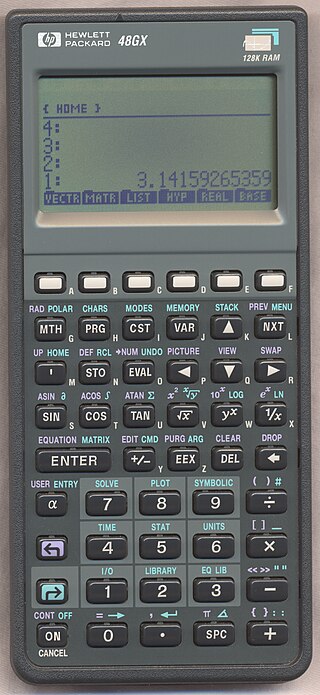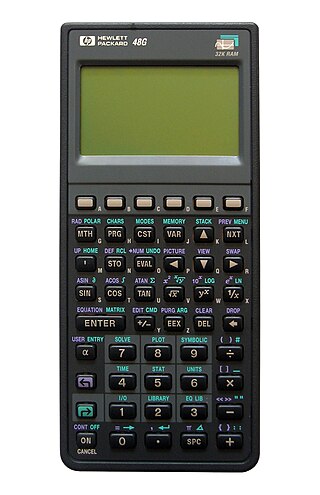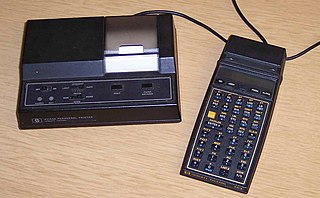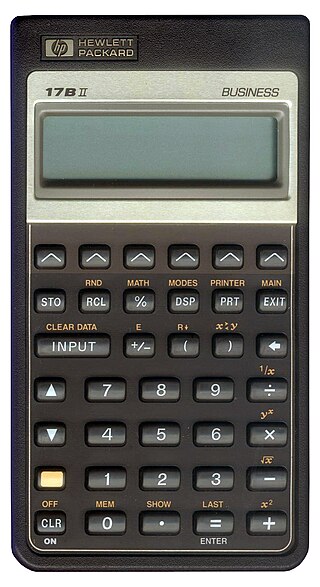Related Research Articles

Reverse Polish notation (RPN), also known as reverse Łukasiewicz notation, Polish postfix notation or simply postfix notation, is a mathematical notation in which operators follow their operands, in contrast to prefix or Polish notation (PN), in which operators precede their operands. The notation does not need any parentheses for as long as each operator has a fixed number of operands.

The HP 48 is a series of graphing calculators designed and produced by Hewlett-Packard from 1990 until 2003. The series includes the HP 48S, HP 48SX, HP 48G, HP 48GX, and HP 48G+, the G models being expanded and improved versions of the S models. The models with an X suffix are expandable via special RAM and ROM cards. In particular, the GX models have more onboard memory than the G models. The G+ models have more onboard memory only. The SX and S models have the same amount of onboard memory.

The HP 49/50 series are Hewlett-Packard (HP) manufactured graphing calculators. They are the successors of the HP 48 series.
In computer programming, digraphs and trigraphs are sequences of two and three characters, respectively, that appear in source code and, according to a programming language's specification, should be treated as if they were single characters. Trigraphs have been removed from the C++ language, and will be from C as of C23, thus likely aren't used much in practice in C already, nor in any other mainstream language. In the modern world of Unicode/UTF-8 there's no need for trigraphs in language design, which were considered a burden, and neither really digraphs, that likely have very few users, at least in those languages.

RPL is a handheld calculator operating system and application programming language used on Hewlett-Packard's scientific graphing RPN calculators of the HP 28, 48, 49 and 50 series, but it is also usable on non-RPN calculators, such as the 38, 39 and 40 series. Internally, it was also utilized by the 17B, 18C, 19B and 27S.

The HP-IL was a short-range interconnection bus or network introduced by Hewlett-Packard in the early 1980s. It enabled many devices such as printers, plotters, displays, storage devices, test equipment, etc. to be connected to programmable calculators such as the HP-41C, HP-71B and HP-75C/D, the Series 80 and HP-110 computers, as well as generic ISA bus based PCs.

The HP-41C series are programmable, expandable, continuous memory handheld RPN calculators made by Hewlett-Packard from 1979 to 1990. The original model, HP-41C, was the first of its kind to offer alphanumeric display capabilities. Later came the HP-41CV and HP-41CX, offering more memory and functionality.

The HP-42S RPN Scientific is a programmable RPN Scientific hand held calculator introduced by Hewlett-Packard in 1988. It is a popular calculator designed for science and engineering students.

The HP-27S was a pocket calculator produced by Hewlett-Packard, introduced in 1988, and discontinued between 1990 and 1993. It was the first HP scientific calculator to use algebraic entry instead of RPN, and though it was labelled scientific, it also included features associated with specialized business calculators.

The HP-12C is a financial calculator made by Hewlett-Packard (HP) and its successor HP Inc. as part of the HP Voyager series, introduced in 1981. It is HP's longest and best-selling product and is considered the de facto standard among financial professionals. There have been multiple revisions over the years, with newer revisions moving to an ARM processor running a software emulator of the original Nut processor. Critics claim that its 1980s technology is antiquated, but proponents point out that it is still the de facto and de jure standard in finance.

The Hewlett-Packard Voyager series of calculators were introduced by Hewlett-Packard in 1981. All members of this series are programmable, use Reverse Polish Notation, and feature continuous memory. Nearly identical in appearance, each model provided different capabilities and was aimed at different user markets.

The HP-19C and HP-29C were scientific/engineering pocket calculators made by Hewlett-Packard between 1977 and 1979. They were the most advanced and last models of the "20" family and included Continuous Memory as a standard feature.

The HP-28C and HP-28S were two graphing calculators produced by Hewlett-Packard from 1986 to 1992. The HP-28C was the first handheld calculator capable of solving equations symbolically. They were replaced by the HP 48 series of calculators, which grew from the menu-driven RPL programming language interface first introduced in these HP-28 series.

The HP 95LX Palmtop PC, also known as project Jaguar, is Hewlett Packard's first DOS-based pocket computer, or personal digital assistant, introduced in April 1991 in collaboration with Lotus Development Corporation. The abbreviation "LX" stood for "Lotus Expandable". The computer can be seen as successor to a series of larger portable PCs like the HP 110 and HP 110 Plus.
A graphing calculator is a class of hand-held calculator that is capable of plotting graphs and solving complex functions. While there are several companies that manufacture models of graphing calculators, Hewlett-Packard is a major manufacturer.
In computing HP Roman is a family of character sets consisting of HP Roman Extension, HP Roman-8, HP Roman-9 and several variants. Originally introduced by Hewlett-Packard around 1978, revisions and adaptations were published several times up to 1999. The 1985 revisions were later standardized as IBM codepages 1050 and 1051. Supporting many European languages, the character sets were used by various HP workstations, terminals, calculators as well as many printers, also from third-parties.

HP-17B is an algebraic entry financial and business calculator manufactured by Hewlett-Packard, introduced on 4 January 1988 along with the HP-19B, HP-27S and the HP-28S. It was a simplified business model, like the 19B. There were two versions, the US one working in English only, and the international one with a choice of six languages.

HP-19B, introduced on 4 January 1988, along with the HP-17B, HP-27S and the HP-28S, and replaced by the HP-19BII (F1639A) in January 1990, was a simplified Hewlett Packard business model calculator, like the 17B. It had a clamshell design, like the HP-18C, HP-28C and 28S.

The HP Prime Graphing Calculator is a graphing calculator introduced by Hewlett-Packard in 2013 and manufactured by HP Inc. until the licensees Moravia Consulting spol. s r.o. and Royal Consumer Information Products, Inc. took over the continued development, manufacturing, distribution, marketing and support in 2022. It was designed with features resembling those of smartphones, such as a full-color touchscreen display and a user interface centered around different applications. It claims to be the world's smallest and thinnest CAS-enabled calculator currently available.
The RPL character set is an 8-bit character set and encoding used by most RPL calculators manufactured by Hewlett-Packard as well as by the HP 82240B thermal printer. It is sometimes referred to simply as "ECMA-94" in documentation, although it is for the most part a superset of ISO/IEC 8859-1 / ECMA-94 in terms of printable characters, and it differs from ISO/IEC 8859-1 by using displayable characters rather than control characters in the 0x80 to 0x9F range of code points.
References
- 1 2 3 RPN Scientific Calculator - Owner's Manual - HP-42S (PDF) (1 ed.). Hewlett-Packard. June 1988. pp. 288–291. 00042-90001, 00042-90002. Archived (PDF) from the original on 2018-01-04. Retrieved 2018-01-04.
- 1 2 HP-42S RPN Scientific - Programming Examples and Techniques (PDF) (1 ed.). Corvallis, OR, USA: Hewlett-Packard Company, Corvallis Division. July 1988. 00042-90020, 00042-90019. Archived (PDF) from the original on 2018-01-04. Retrieved 2018-01-04.
- ↑ Hicks, David G. (2017) [1998]. "HP-41C Synthetic Programming". The Museum of HP Calculators (MoHPC). Archived from the original on 2018-01-06. Retrieved 2018-01-06.
- ↑ Hicks, David G. (1997). "Graphic byte code table". The Museum of HP Calculators (MoHPC). Archived from the original on 2018-01-06. Retrieved 2018-01-06.
- ↑ Nelson, Richard J. (May 2010). "HP 82240B IR Printer" (PDF). HP Solve (18). Archived from the original (PDF) on 2016-09-21. Retrieved 2016-09-21.
- ↑ HP 82240A Infrared Printer (PDF) (2 ed.). Corvallis, OR, USA: Hewlett Packard, Portable Computer Division. October 1986. HP reorder number 82240-90001 (82240-90008). Archived (PDF) from the original on 2016-08-06. Retrieved 2016-08-06.
- ↑ HP 82240B Infrared Printer (1 ed.). Corvallis, OR, USA: Hewlett Packard. August 1989. pp. 17–18. HP reorder number 82240-90014.